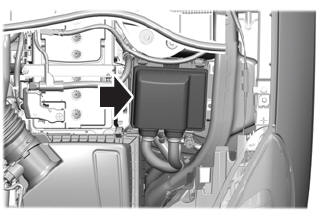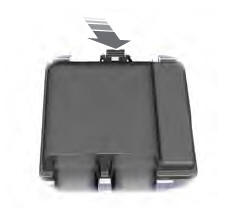Ford Escape 2020-2025 Service Manual / Chassis / Steering System / Steering Wheel and Column Electrical Components / Removal and Installation - Steering Column Control Module (SCCM)
Ford Escape: Steering Wheel and Column Electrical Components / Removal and Installation - Steering Column Control Module (SCCM)
Removal
NOTE: Removal steps in this procedure may contain installation details.
-
NOTE: This step is only necessary when installing a new component.
NOTE: The PMI process must begin with the current SCCM installed. If the current SCCM does not respond to the diagnostic scan tool, the tool may prompt for As-Built Data as part of the repair.
Using a diagnostic scan tool, begin the PMI process for the SCCM following the on-screen instructions.
-
Remove the steering wheel.
Refer to: Steering Wheel (211-04 Steering Column, Removal and Installation).
-
Remove the steering column shrouds.
Refer to: Steering Column Shrouds (501-05 Interior Trim and Ornamentation, Removal and Installation).
-
Disconnect the SCCM electrical connectors and position the wiring harness aside.
 |
-
Remove the retainers and the SCCM .
Torque: 27 lb.in (3 Nm)
 |
Installation
-
To install, reverse the removal procedure.
-
NOTE: This step is only necessary when installing a new component.
Using a diagnostic scan tool, complete the PMI process for the SCCM following the on-screen instructions.
 Diagnosis and Testing - Steering Wheel and Column Electrical Components
Diagnosis and Testing - Steering Wheel and Column Electrical Components
Diagnostic Trouble Code (DTC) Chart
Diagnostics in this manual assume a certain skill level and knowledge of Ford-specific diagnostic practices. REFER to: Diagnostic Methods (100-00 General Information, Description and Operation)...
 Removal and Installation - Ignition Lock Cylinder Housing
Removal and Installation - Ignition Lock Cylinder Housing
Removal
Remove the SCCM .
Refer to: Steering Column Control Module (SCCM) (211-05 Steering Wheel
and Column Electrical Components, Removal and Installation)...
Other information:
Ford Escape 2020-2025 Service Manual: Removal and Installation - Rear Seat Armrest
Special Tool(s) / General Equipment Interior Trim Remover Removal NOTE: Removal steps in this procedure may contain installation details. Remove the rear seat. Refer to: Rear Seat (501-10B Rear Seats, Removal and Installation)...
Ford Escape 2020-2025 Owners Manual: Switching Pre-Collision Assist On and Off
You cannot switch the system off. Adjusting the Pre-Collision Assist Settings You can adjust the following settings by using the touchscreen controls in the pre-collision assist menu: Change alert and distance alert sensitivity to one of three possible settings...
Categories
- Manuals Home
- 4th Generation Ford Escape Owners Manual
- 4th Generation Ford Escape Service Manual
- Adjusting the Headlamps
- Symbols Glossary
- What Is the Tire Pressure Monitoring System. Tire Pressure Monitoring System Overview
- New on site
- Most important about car
Under Hood Fuse Box
Locating the Under Hood Fuse Box

Accessing the Under Hood Fuse Box

Copyright © 2025 www.fordescape4.com
